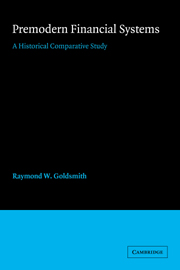Book contents
- Frontmatter
- Contents
- List of tables
- Preface
- 1 Introduction
- 2 The financial systems of the ancient Near East
- 3 The financial system of Periclean Athens
- 4 The financial system of Augustan Rome
- 5 The financial system of the early Abbasid caliphate
- 6 The financial system of the Ottoman Empire at the death of Suleiman I
- 7 The financial system of Mughal India at the death of Akbar
- 8 The financial system of early Tokugawa Japan
- 9 The financial system of Medici Florence
- 10 The financial system of Elizabethan England
- 11 The financial system of the United Provinces at the Peace of Münster
- 12 Similarities and differences
- Notes
- Bibliography
- Index
6 - The financial system of the Ottoman Empire at the death of Suleiman I
Published online by Cambridge University Press: 05 March 2012
- Frontmatter
- Contents
- List of tables
- Preface
- 1 Introduction
- 2 The financial systems of the ancient Near East
- 3 The financial system of Periclean Athens
- 4 The financial system of Augustan Rome
- 5 The financial system of the early Abbasid caliphate
- 6 The financial system of the Ottoman Empire at the death of Suleiman I
- 7 The financial system of Mughal India at the death of Akbar
- 8 The financial system of early Tokugawa Japan
- 9 The financial system of Medici Florence
- 10 The financial system of Elizabethan England
- 11 The financial system of the United Provinces at the Peace of Münster
- 12 Similarities and differences
- Notes
- Bibliography
- Index
Summary
Though separated by over seven centuries the Ottoman Empire at the death of Suleiman the Magnificent and the Abbasid caliphate at the death of Harun al Rashid were very similar in location, population, and political, economic, and financial structure. Eastern Anatolia, Mesopotamia, Arabia, Syria, Egypt, and the eastern part of the Maghreb were common to both empires. Although the Ottoman Empire did not include Iran and Sind, it did include Western Anatolia, the Balkans, and Hungary. Both empires had close to 30 million inhabitants and hence a similar density of population. Both were predominantly Muslim, but tolerant of religious minorities, and the Koran and the Sharia, the canon law of Islam, provided the framework for daily life. Arabic was the lingua franca in both. Politically, both were autocracies, the monarch being the religious as well as the civil head of the state. Both were primarily agricultural with a low degree of urbanization. Foreign trade played a minor role in their economy and their financial system was rudimentary. Finally, the level of real national product probably was not very different, though possibly somewhat higher in the Ottoman Empire. Changes in the techniques of agriculture, manufacturing, transportation, trading, and government as well as private finance were small for a distance of threefourths of a millennium (cf. Inalcik 1969, p. 135).
- Type
- Chapter
- Information
- Premodern Financial SystemsA Historical Comparative Study, pp. 80 - 93Publisher: Cambridge University PressPrint publication year: 1987



